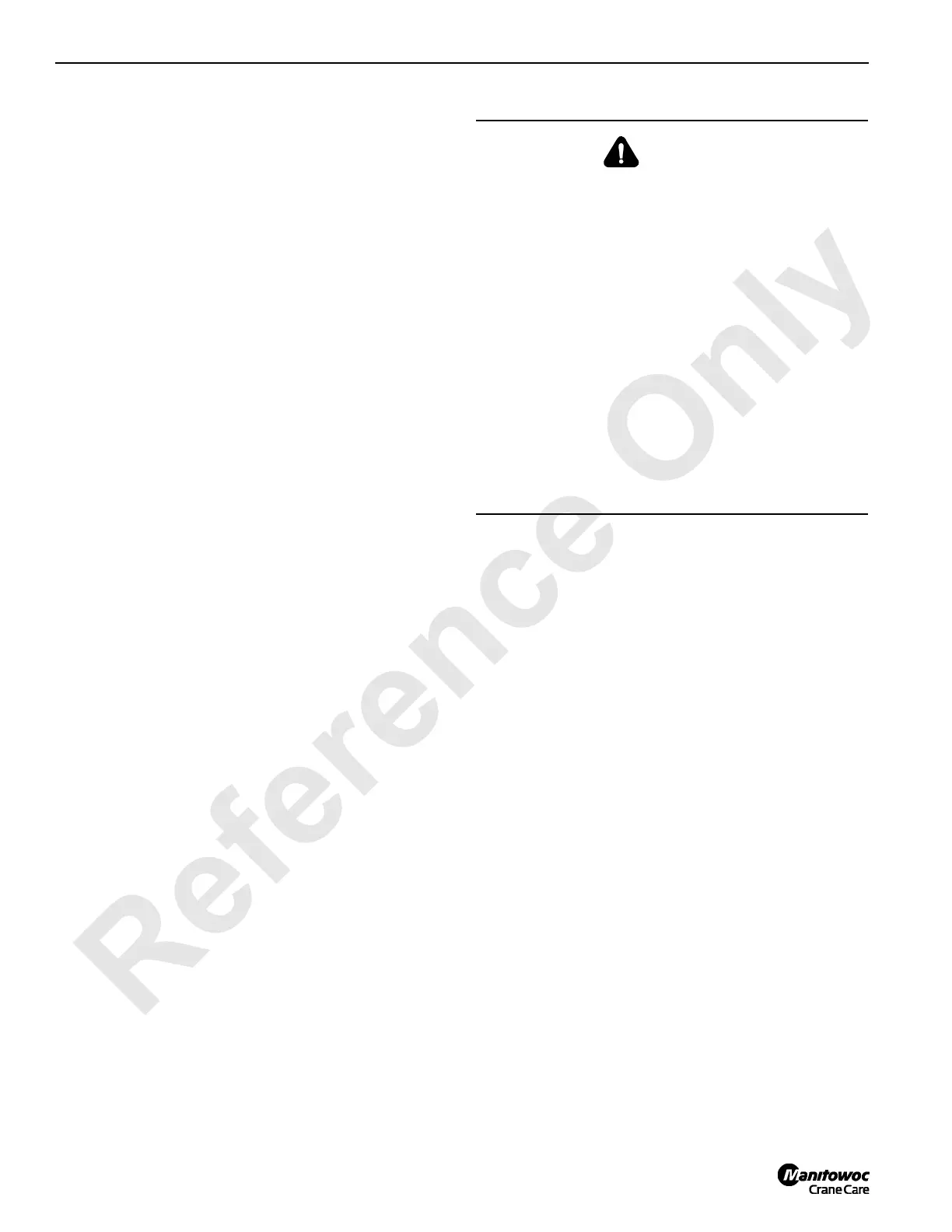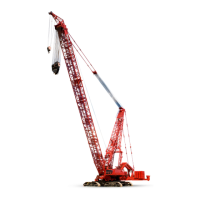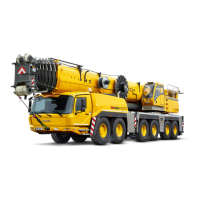HOISTS 777 SERVICE MANUAL
5-12 Published 10-01-2012, Control # 045-08
DRUM BRAKE ADJUSTMENT
Two types of brakes are provided on right end of both load
drums:
• An external, contracting, band-type brake (wrapped
around drum flange) and an actuator. See Figure 5-12.
• A disc brake between drive motor and planetary.
NOTE: If your crane has optional high line pull drum,
brakes identical to those on right end of drum are
also mounted on left end of drum.
Full-Power Operation (Free Fall Off)
Band and disc brakes operate automatically in conjunction
with operation of load drum control handles:
• When a drum control handle is moved in either direction
from off to hoist or lower a load, corresponding band and
disc brakes are hydraulically released.
• When drum control handle is returned to off, band and
disc brakes are spring applied to stop drum and hold the
load in position.
Free Fall Operation (Optional)
Automatic operation of band brakes is turned off:
• When a drum control handle is moved in either direction
from off to hoist or lower a load, corresponding band
brake must be manually released with foot pedal to allow
drum to turn.
• When drum control handle is returned to off,
corresponding band brake must be manually applied
with foot pedal to stop drum and hold the load in
position. Braking control is variable, from fully applied to
fully released, depending on position of the foot pedal.
Automatic operation of disc brakes remains on:
• When a drum control handle is moved in either direction
from off to hoist or lower a load the corresponding disc
brake is hydraulically released to allow the drum to turn.
• When drum control handle is returned to off the disc
brake is spring applied. The brake prevents motor side
of drive from turning until free fall clutch is fully engaged
before hoisting or lowering a load.
NOTE: Disc brakes are not adjustable. See Disc Brake
Operational Test in Section 2 of this manual for
testing and servicing instructions.
Brake Inspection
See Figure 5-12 for following procedure.
1. Inspect all pins and linkage for excessive wear; replace
parts as required. Excessively worn pins and linkage
make it difficult to obtain proper drum-to-lining
clearance.
2. Lubricate pins in linkage with a few drops of engine oil.
Lubricate grease fittings according to Lubrication Guide.
3. With drum brakes applied, check each brake for proper
adjustment at drum brake adjustment indicator
(Figure 5-12, View B). Check adjustment when linings
are cold for liftcrane work or warm from operation for
duty-cycle work.
• As brake lining wears, leading edge of spring sleeve
inside brake actuator moves closer to end of
actuator.
• Readjust brake when leading edge of spring sleeve
reaches line at end of safe working range on
adjustment indicator.
The SAFE WORKING RANGE is 3/8 in. (9.5 mm)
wide.
WARNING
Personnel Injury Hazard!
Brake inspection and adjustment, requires two people:
one to operate drum brakes and one to perform
inspection and adjustment steps. Steps are performed
with engine running. Maintain constant communication
between operator and adjuster so load drums are not
operated while adjuster is in contact with parts.
• Lower all loads to ground so load lines are slack.
Keep loads on ground for all inspection and
adjustment steps.
• Adjuster, avoid injury from moving machinery. Stay
clear of all moving parts while drum brakes are being
operated.
• Operator, make sure load drum handles are in off
position while inspection and adjustment steps are
performed. Do not operate drum brakes until adjuster
is clear of moving parts.

